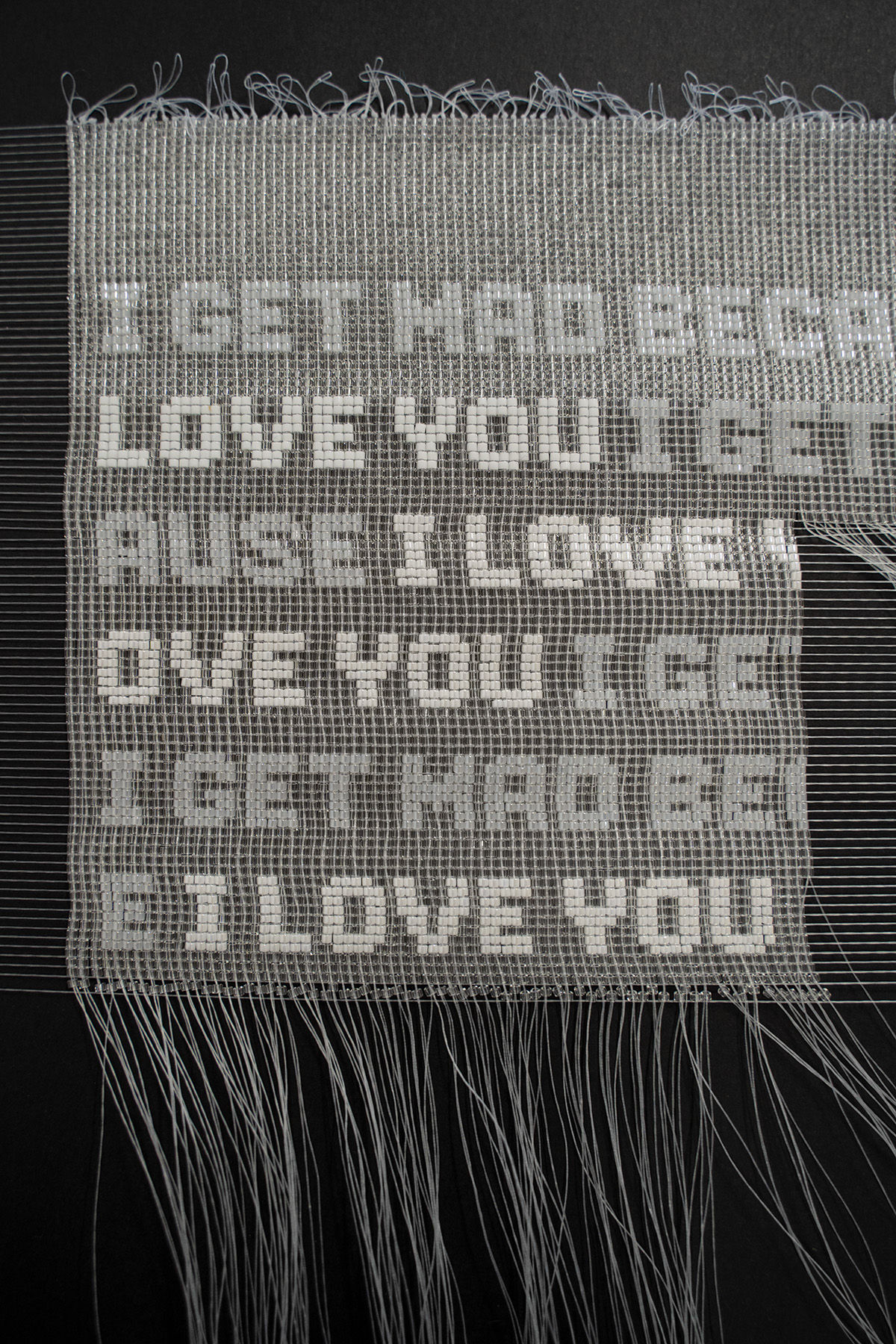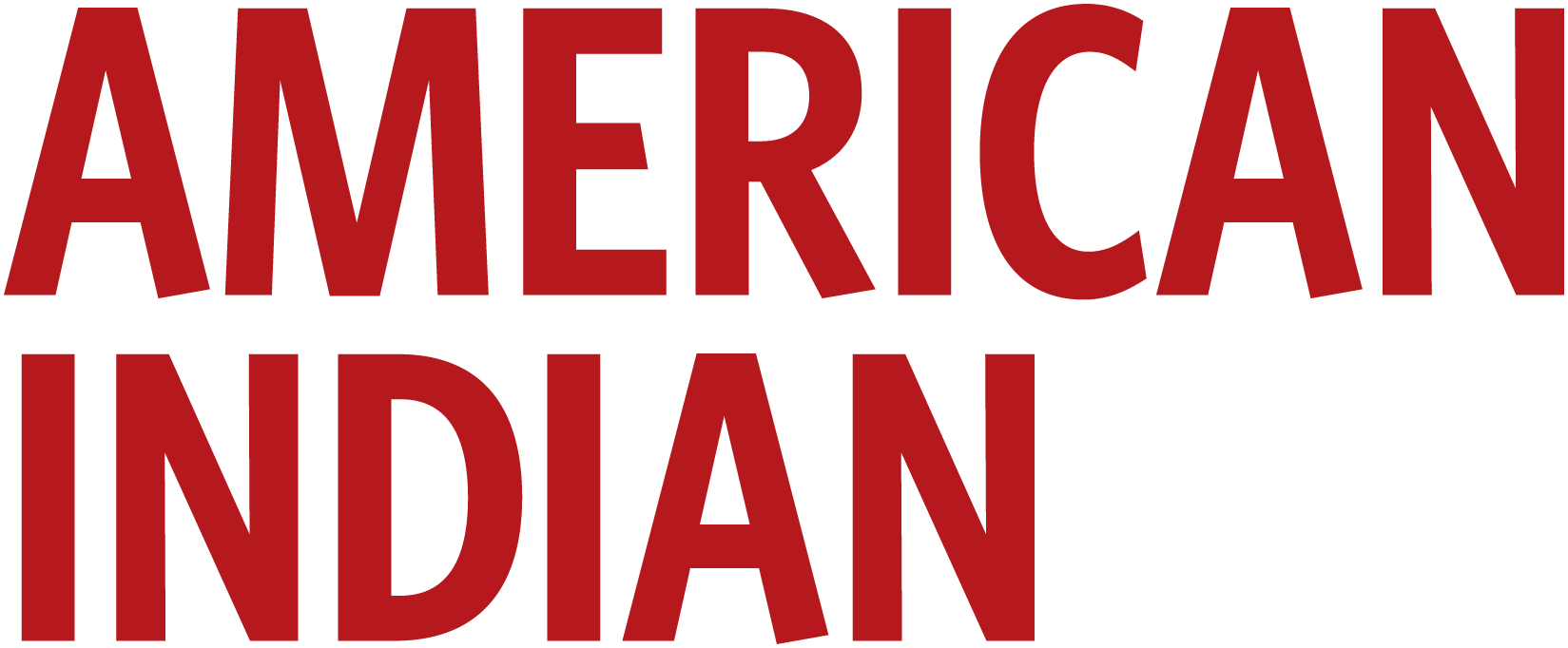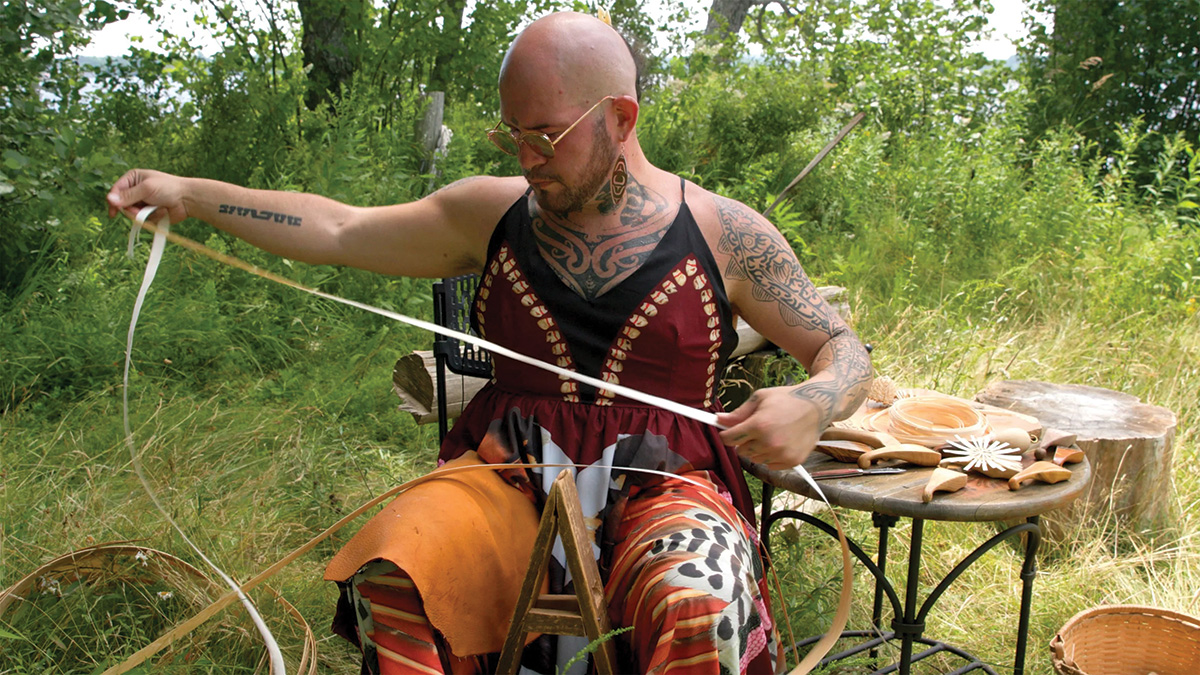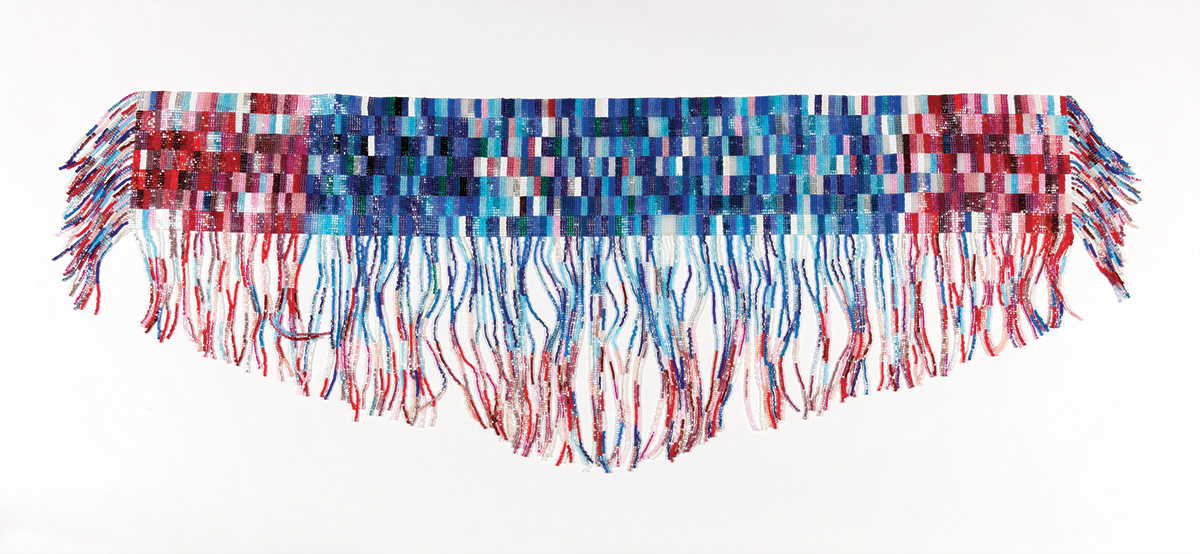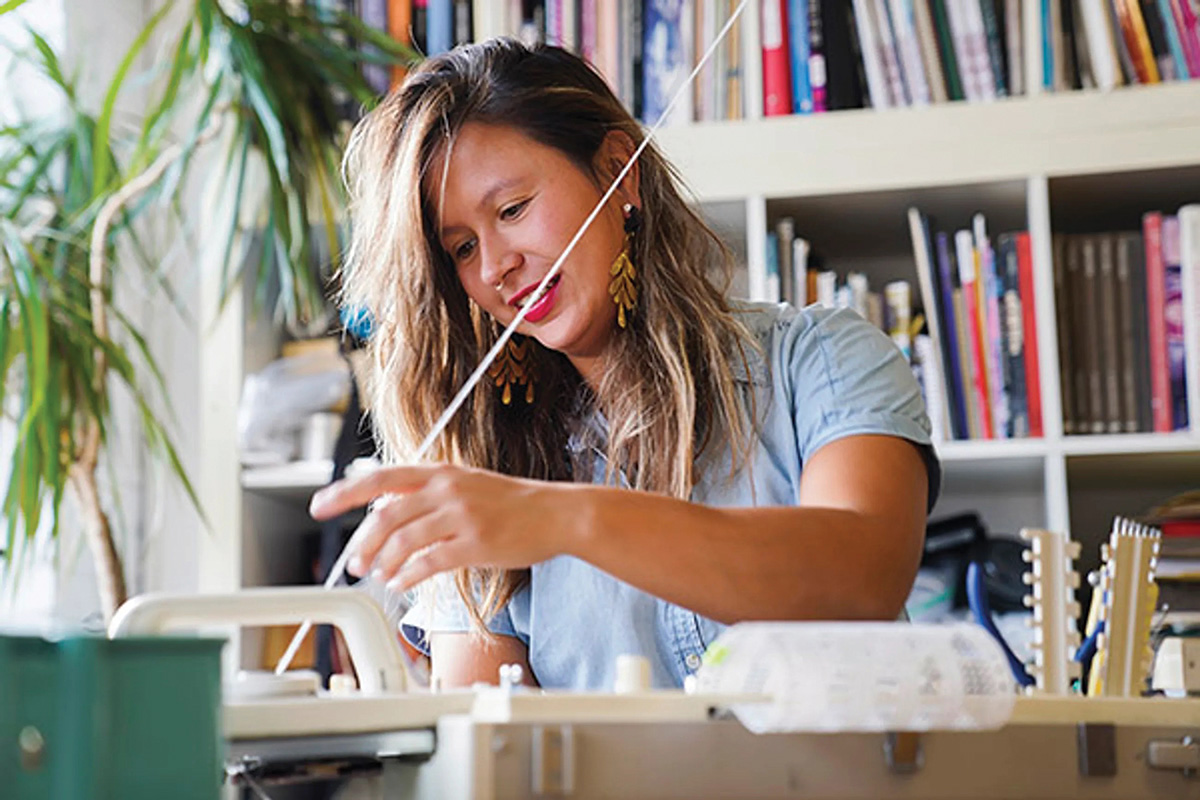For more than two decades, the Renwick Gallery of the Smithsonian American Art Museum (SAAM) has been dedicated to exhibiting art that exemplifies American Craft. Although these artworks are typically made of materials that make up Indigenous art—wood, glass, metal, clay and cloth—Native works have often been thought of more as “traditional” or “cultural” art and so hadn’t graced the museum’s exhibit halls.
In 2023, that changed. For the first time, the museum is showcasing six mid-career and emerging Native American and Alaska Native artists who were chosen among hundreds of others for their dedication to carrying on their ancestors’ skills while also making their own mark in the art world. “Sharing Honors and Burdens: Renwick Invitational 2023,” which will be open for viewing until March 2024, displays works in a variety of mediums from Joe Feddersen (Arrow Lakes/Okanagan), Lily Hope (Tlingit), Ursala Hudson (Tlingit), Erica Lord (Athabaskan/Iñupiat), Geo Neptune (Passamaquoddy) and Maggie Thompson (Fond du Lac Ojibwe). These artworks arise from traditions that honor the artists’ family, community or clan.
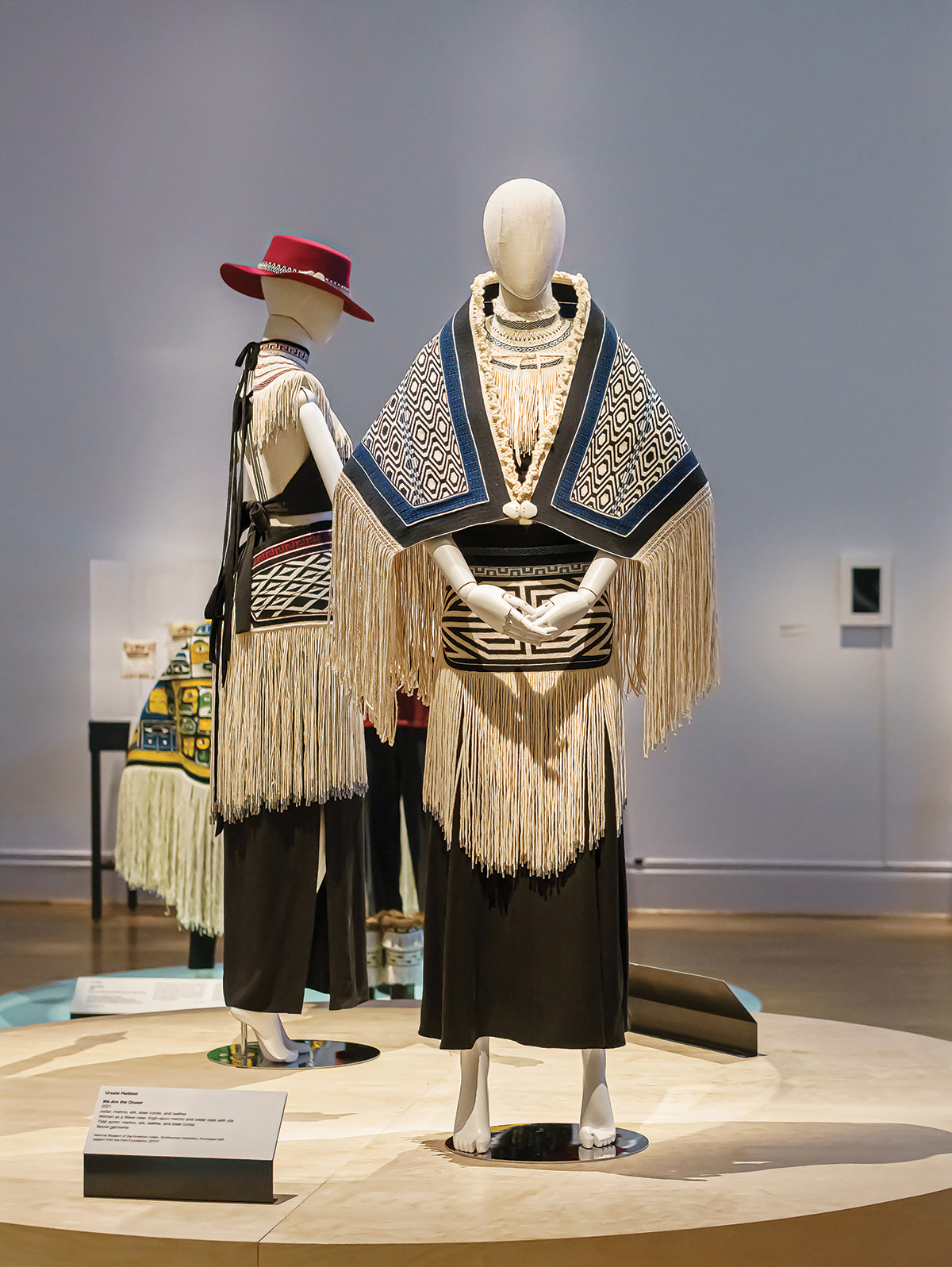
“We Are the Ocean” ceremonial dance ensemble by Ursala Hudson on display at the Renwick Gallery of the Smithsonian American Art Museum. Courtesy of Smithsonian American Art Museum
2021, “Woman as a Wave” robe: thigh-spun merino wool and cedar bark, silk, leather and steel cones; “Tidal” apron: merino wool, silk, leather and steel cones; collar: merino wool, silk, steel cones and leather. National Museum of the American Indian 27/717
Lara Evans, a guest curator from the Cherokee Nation who organized the exhibition in partnership with SAAM, explained that the exhibition’s title reflects “the things that we hold in our life that we don’t want to hold” as well as “the things we are proud to hold or proud to carry forward. … What are our obligations to one another in the past into the future?,” she posed. “Those are things we can all consider regardless of what our cultural background is or our life experience might be.”
Stephanie Stebich, the Margaret and Terry Stent Director of the SAAM, explained the works are “innovative and deeply aligned with contemporary experience. While each artist uses different craft materials and techniques to explore a range of topics, all create works that speak to personal and communal honors and burdens and reflect on the responsibility of sharing these with the wider world.”
Among the 55 works of art on exhibition, 13 were created within the past year and SAAM commissioned three specifically for the exhibition: “Between Worlds,” a woven child’s robe by Lily Hope; “Sister Bear,” a woven Tlingit robe by Ursala Hudson; and “The Codes We Carry,” a set of beaded sled dog blankets by Erica Lord that are displayed on dog sculptures and show the DNA patterns of diseases.
The works of sisters Hope and Hudson balance both traditional and contemporary clothing with intricate Tlingit designs, showing both the honor and burden of learning such complex weaving techniques. Geo Neptune’s traditional baskets and Joe Feddersen’s blown-glass vessels convey messages about the modern world. Lord beads straps of burden, such as those that are used to carry babies, with designs that, instead of traditional floral or abstract designs, reflect the burdens of disease caused by poverty or environmental damage. Maggie Thompson uses weaving and knitting to explore relationships as well as identity, grief and loss.
Evans said Indigenous art can still be considered American Craft as it is “accessible work that has meaning to everyone. So while there are specialized formats or techniques that are historically rooted, the work is also intended to communicate cross-culturally.”
As the curators write in the exhibition’s companion catalog of the same name, “The burdens we carry are not always negative; some are chosen and held with pride and dedication. The honors are not simple celebratory recognitions of past achievements; they mark changes in responsibilities and shifting relationships. The making changes the maker. The sharing changes us all.”
Following are the six artists and some of their works featured in the “Sharing Honors and Burdens: Renwick Invitational 2023” exhibition.
Lily Hope (Tlingit)

Tlingit sisters and weavers Lily Hope (left) and Ursala Hudson.
Photo Courtesy of the Artists
Lily Hope belongs to her grandmother’s Alaska Native T’akdeintaan clan and is a daughter of the renowned traditional weaver Clarissa Rizal. She is a master weaver of ceremonial blankets, garments and textiles versed in traditional Ravenstail and Chilkat weaving techniques, which are so labor intensive that two of the robes in the exhibit took two and a half years to create.
Hope joked that her mother tricked her into taking on the art form, having always asked her to assist, and she said her methodology to create is what inspires her to continue. “Intentionality with gratitude is paramount,” she said.“When I’m in the work, I’m really kind of in a flow state. It’s very much like I am a conduit for bringing a being to life.”
“They’re not just a record of our Indigenous identity, our ceremony and our beingness in the world. It’s also a record of this particular artist for two and a half years,” she said. “I can look at those rows and say, ‘Oh, that’s where I had zero childcare, and that section was woven with small children at my feet. It’s a record of who we are. I think about that, looking at historic pieces.”
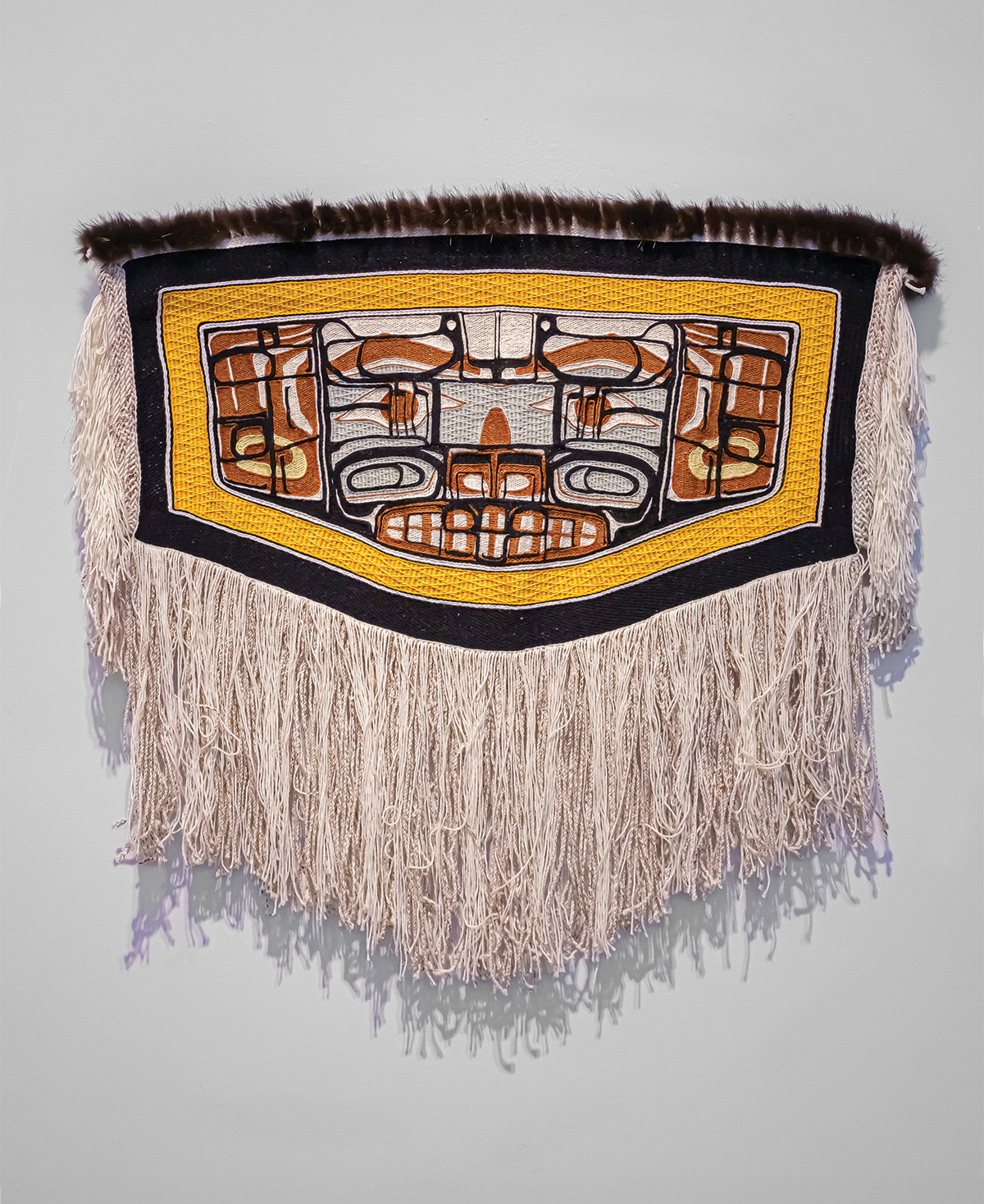
“Between Two Worlds”
Robe, 2022–2023, thigh-spun merino wool, cedar bark warp, acid and naturally dyed marin weft and beaver fur; 36″ × 34″ × .25″.
Courtesy of Lily Hope
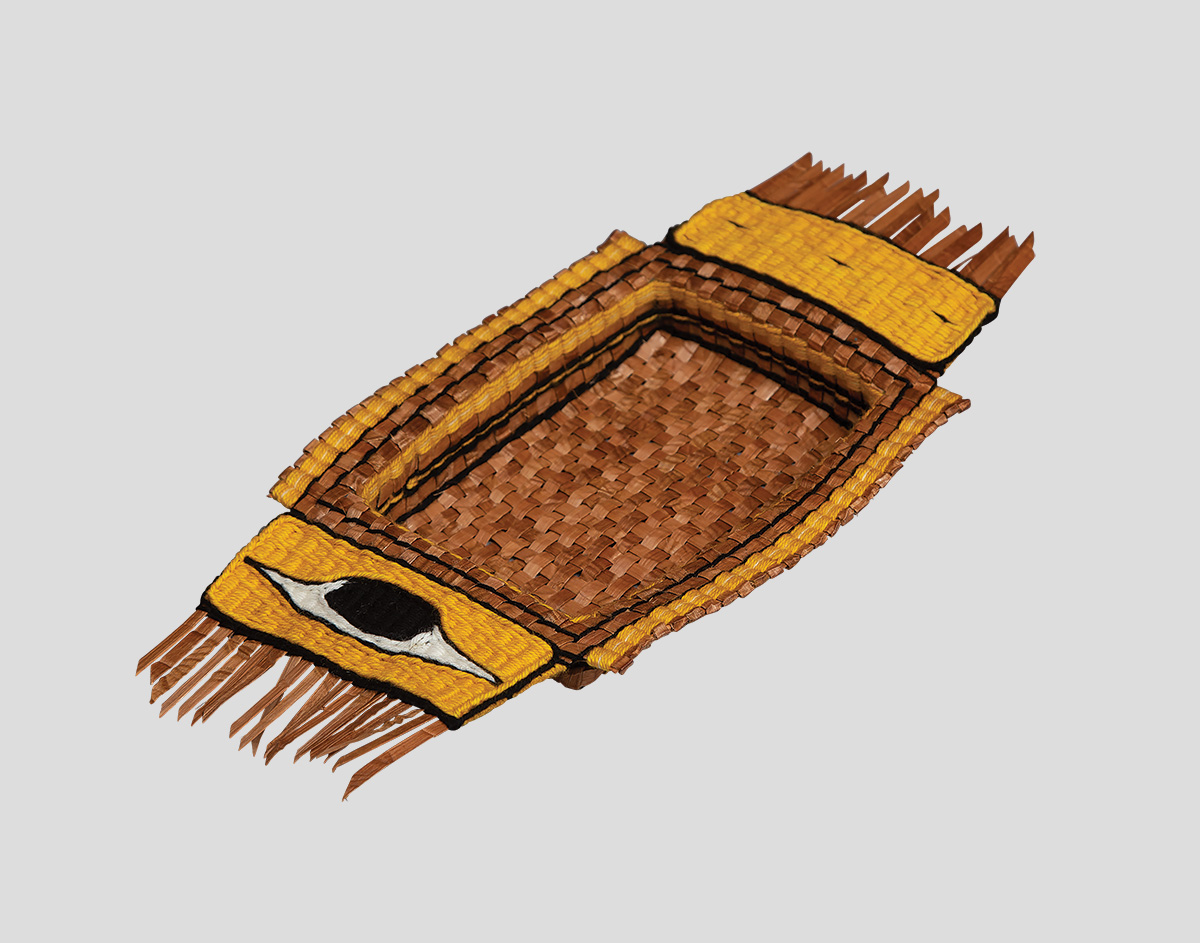
“Clarissa’s Fire Dish”
2021, cedar bark and merino wool; 13″ × 7″ × 1.5″.
Courtesy of the Hope Family Trust
Ursala Hudson (Tlingit)
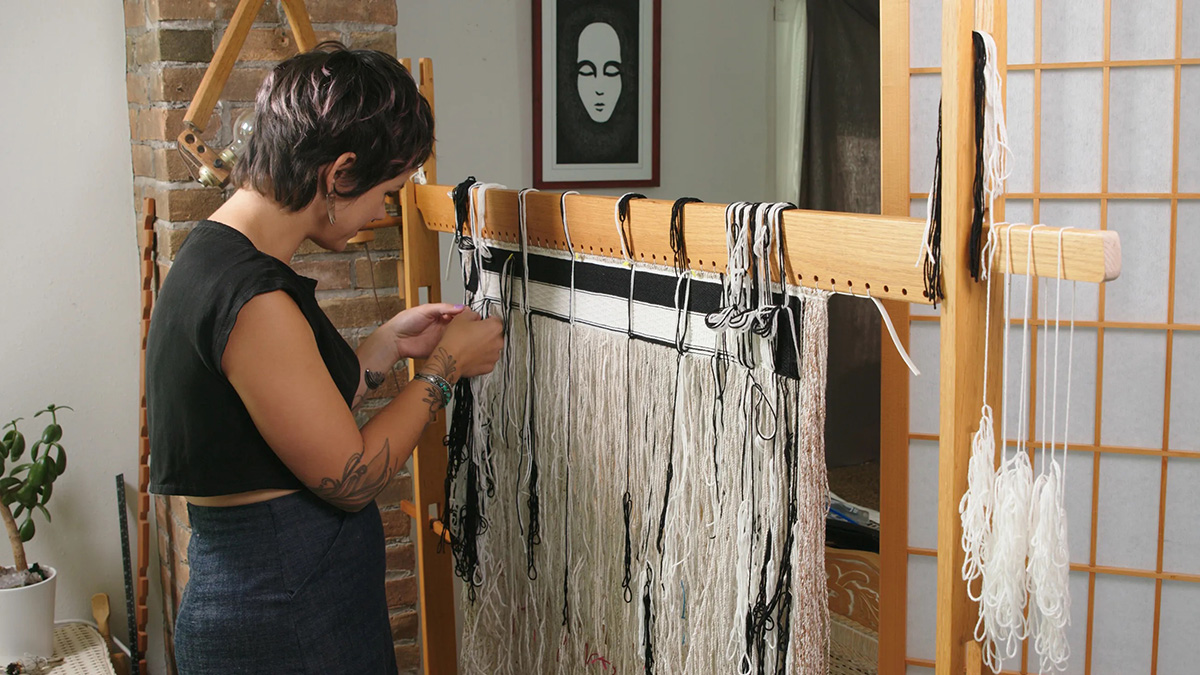
Image by Kaela Waldstein, Mountain Mover Media
Ursala Hudson, who is the sister of Lily Hope, started her journey into the art world by pursuing a career as a graphic designer. But then she came back to her family’s tradition of Chilkat and Ravenstail weaving because, as she said, “I don’t think I could have ever became anything else.” Hudson said following the Tlingit traditions and guidance of her mother and sister “was my way of coming home and figuring out what my lineage was—embracing it and all the different parts of me and my complex heritage.”
Hudson’s work effectively blurs the lines of traditional weaving methodologies with current fashion trends. “I was raised in a modern age with all these global influences while in a predominantly white community. Those things make me translate the traditional work I do and the values of my Indigenous heritage in a very different way than what my Mom did or what her teachers did.”
Though she has won a multitude of accolades, including Best of Show awards, and has walked the runways of elite fashion shows, Hudson said she still feels a bit out of place in the Renwick exhibition. “I’m the newest to a full-time art career out of the six of us. … I feel very honored to get to share the space with so many other artists who I really look up to, who have really paved the way for me and all the other Indigenous artists over the past couple of decades.”
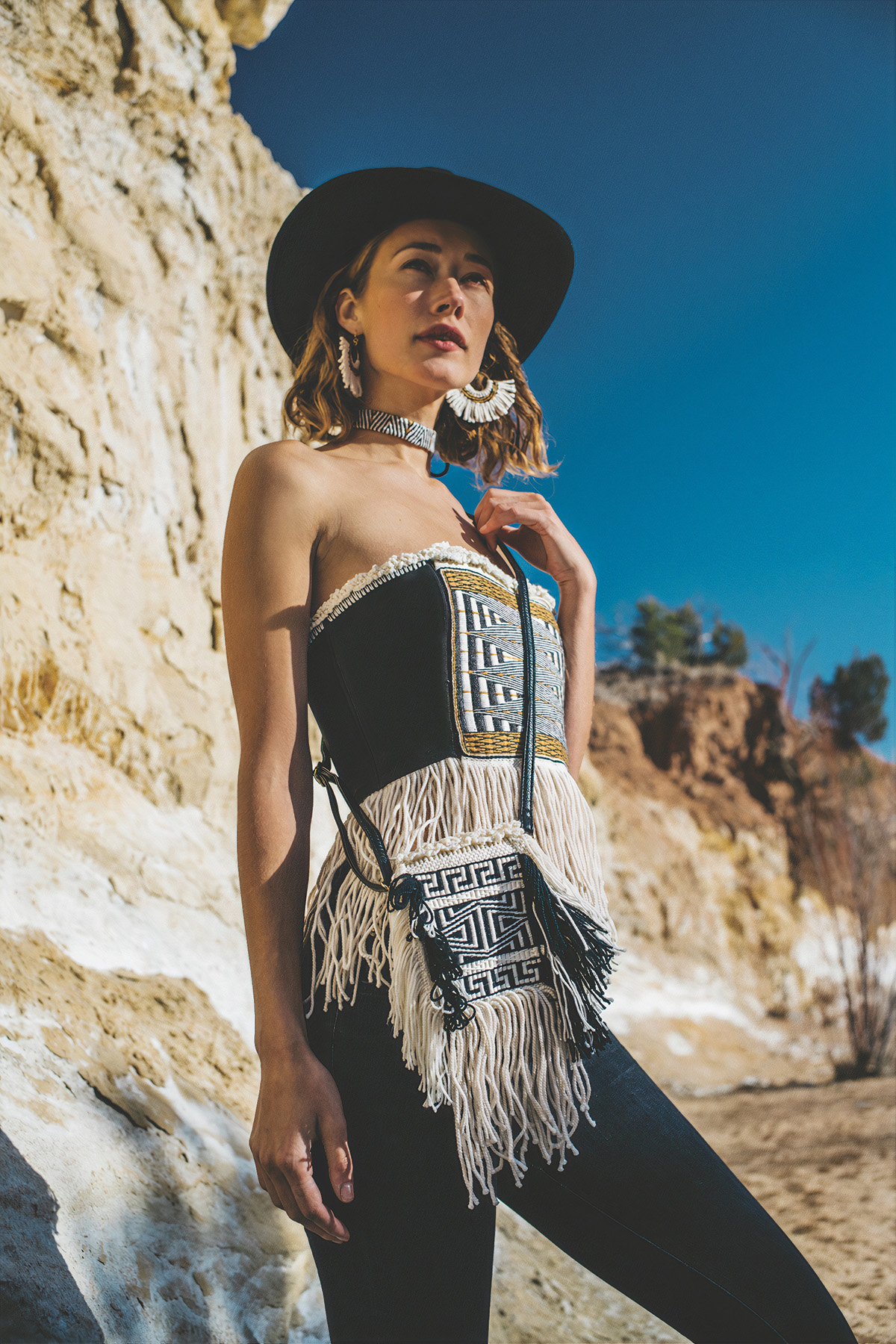
”Lightening at Dawn”
2021, bodice: merino wool, silk, leather and plastic boning; bag: merino wool and leather; vintage hat: merino wool, silk, feather, and mother of pearl.
Photo by Kahlil Hudson
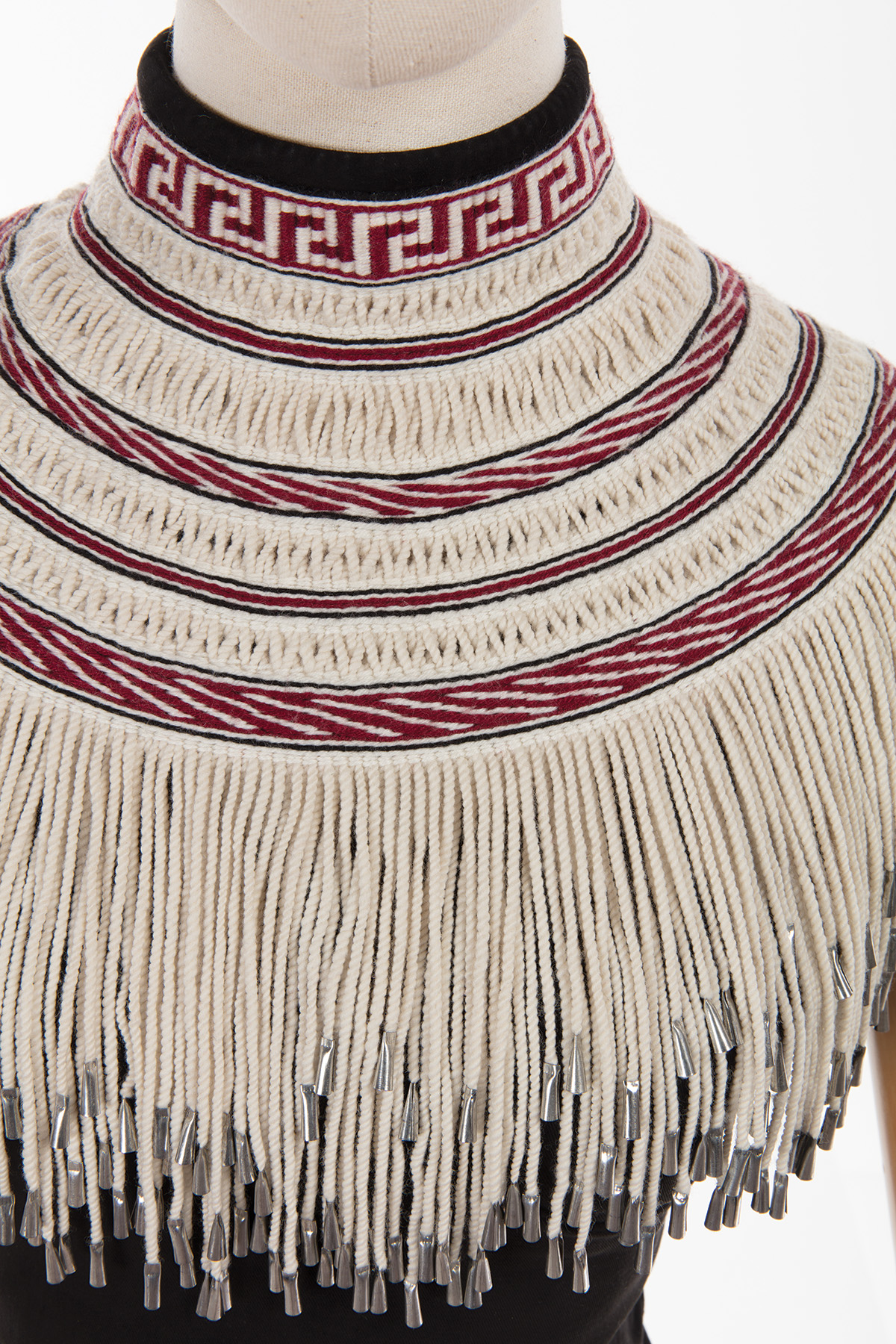
Collar from “Matriarch Rising” Ensemble
2021, merino wool, silk, steel cones and leather.
Photo by Addison Doty, Courtesy of Ursala Hudson
Joe Feddersen (Colville Confederated Tribes/Arrow Lakes/Okanagan)
Image by Kaela Waldstein, Mountain Mover Media
An Okanagan and Arrow Lakes artist and member of the Colville Confederated Tribes, Joe Feddersen said he enjoys merging the concepts of contemporary urban imagery with traditional petroglyphs to create his glass works, basketry and prints. “It’s very process-oriented. A lot of times, the reality is that the content is what’s driving the work,” said Feddersen.
“It’s sometimes a burden to have to explain your culture to everybody. When colonialism decimated our people, I think we lost a lot of the stories. … These are my stories.”
He said humor drives his work, and many of his basketry patterns have playful, contemporary themes with characters that are animated or smiling and even have patterns with antennas, alien faces and more. A pivotal moment in his career as an artist was when a mentor and friend, Skagit elder Vi Hilbert, told him,“You’re not an artist; you’re a storyteller.”
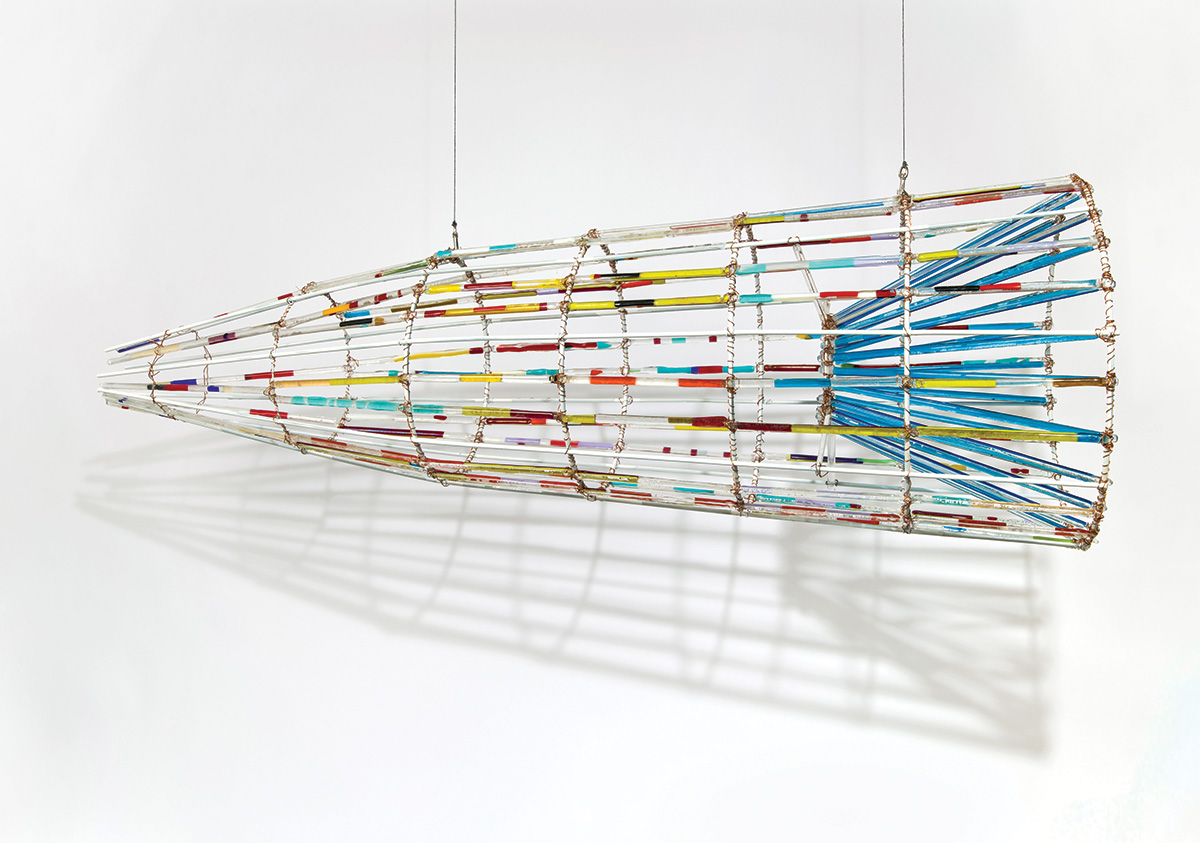
“Fish Trap”
2021–2022; fused glass and metal; 24″ × 72″ × 24″.
Photo by Mario Gallucci, Courtesy of Joe Feddersen

Left to right: “Roll Call,” “Canoe Journey” and “Omak Stampede”
2021; twined wax linen; 7.75″ × 6.25″, 7″ × 5″, 9″ × 6″. Private collection; Colville Tribal Museum, Confederated Tribes of the Colville Reservation; Courtesy of the artist and Studio e.
Photo by Mario Gallucci, Courtesy of Joe Feddersen
Geo Soctomah Neptune (Passamaquoddy)
Image by Kaela Waldstein, Mountain Mover Media
Geo Neptune, who is two spirit and whose pronouns are they and them, began learning how to weave baskets at the age of 4 from their grandmother. By age 11, Neptune was a teacher at the Maine Basketmakers Alliance, and by 20, had become a master basket maker.
In a video produced by Mountain Mover Media in partnership with the Institute of American Indian Arts and the Smithsonian American Art Museum, Neptune said their use of black ash wood to create baskets is significant because “as Wabanaki people, we not only have that deep ancestral and spiritual connection to the material that we use. ... There is that innate Creator energy of taking the material that we were created from [and] giving it a piece of their spirit so that it can take physical form and live life on its own.”
Neptune considers traditional basket forms and then adds their own spin. Neptune said, “I do a whole lot of things in ways that maybe people don’t expect.”
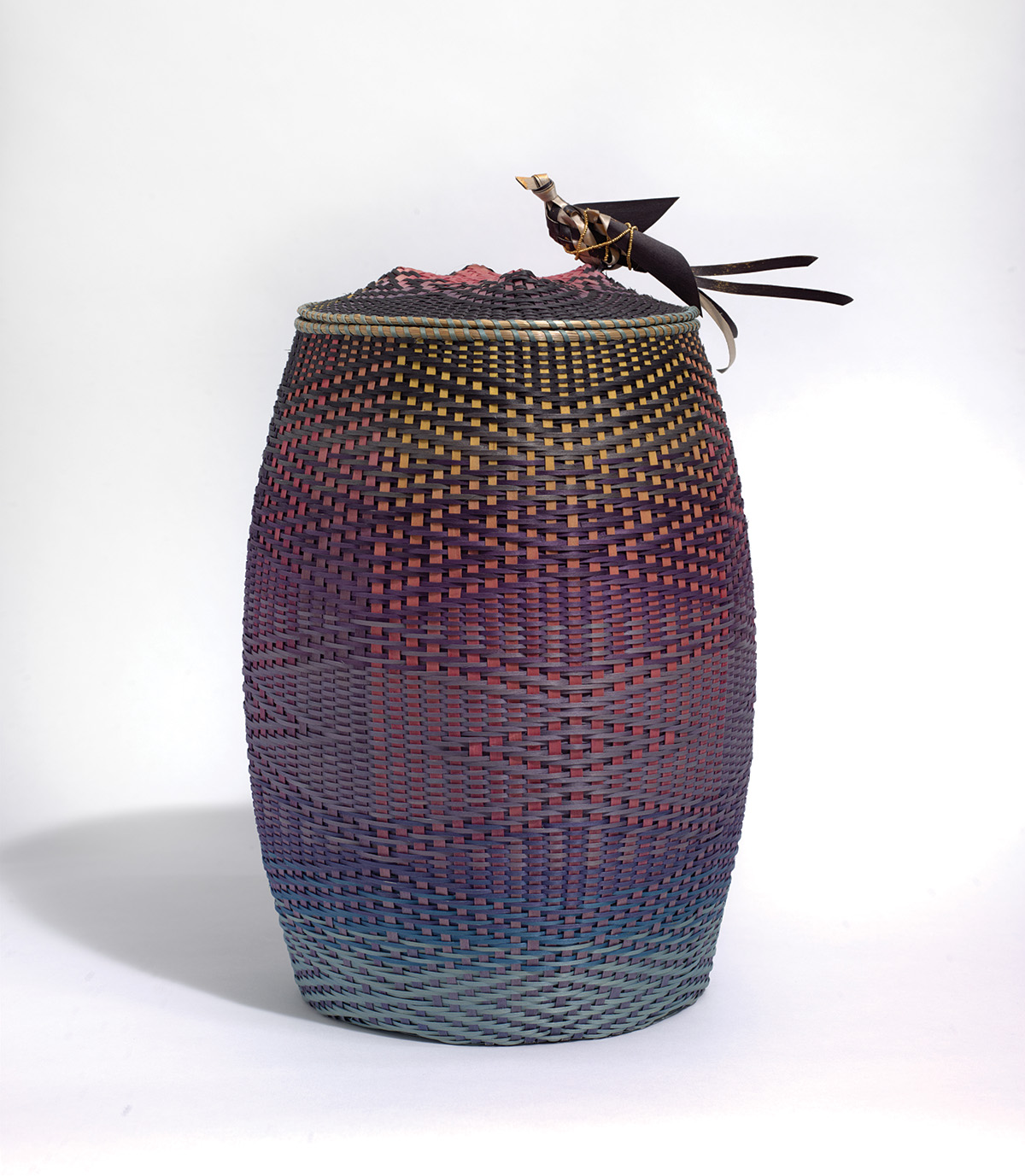
“Apikcilu Binds the Sun”
2018; ash and sweetgrass with commercial dye, acrylic ink and 24-karat gold-plated beads; 16.5″ × 9″. Bowdoin College Museum of Art, Brunswick, Maine, Museum Purchase, The Philip Conway Beam Endowment Fund.
Photo by Luc Demers, Courtesy of Geo Soctomah Neptune
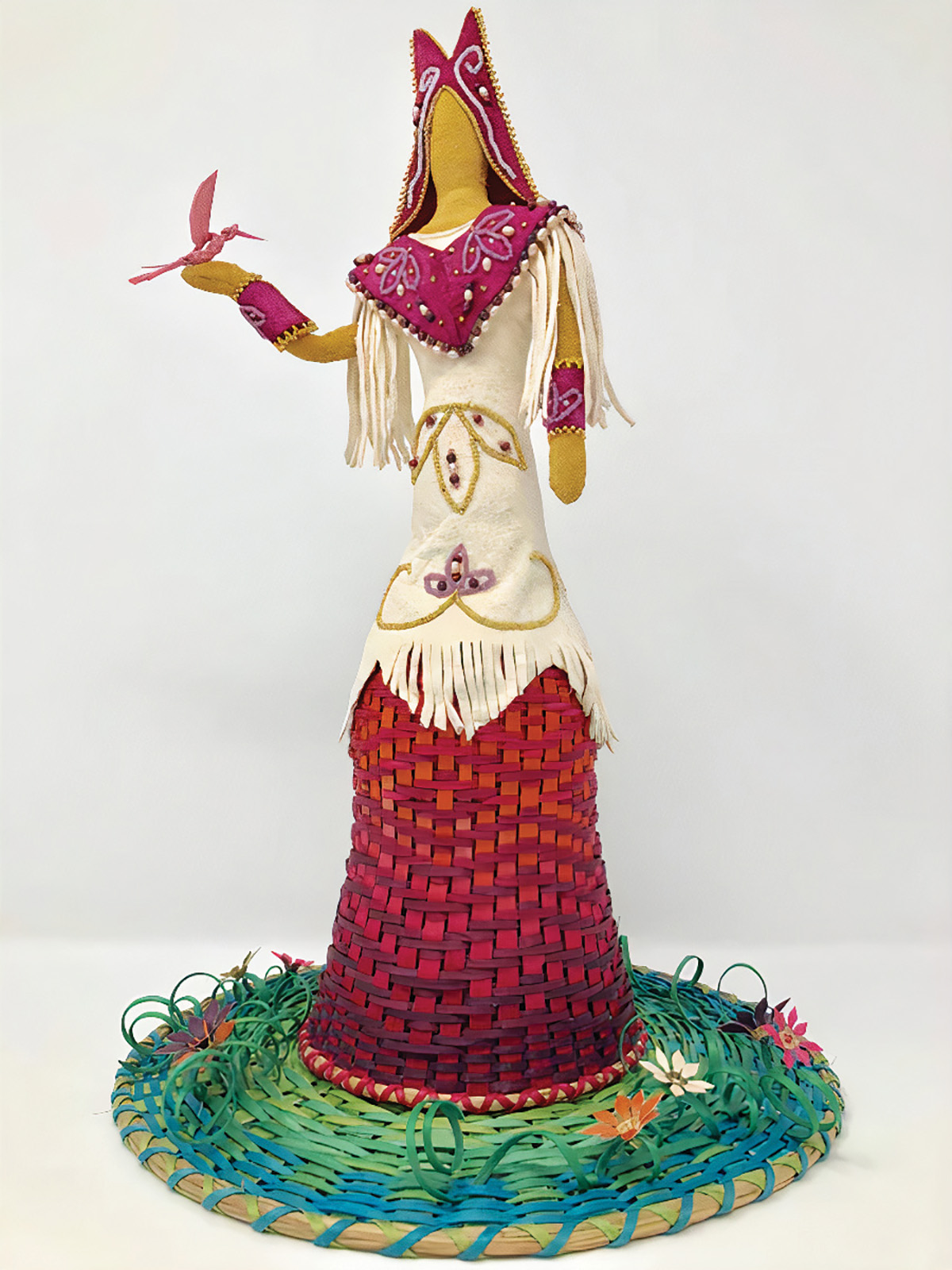
“Piluwapiyit: The Powerful One"
2018; black ash and sweetgrass with commercially tanned deer skin, brain-tanned deer skin, cochineal-dyed deer skin, 24-karat gold-plated beads, freshwater pearls, garnets and charlotte-cut glass beads; 13″ × 8″ × 8″.
Photo by Luc Demers, Courtesy of Geo Soctomah Neptune
Erica Lord (Athabaskan/Iñupiat)
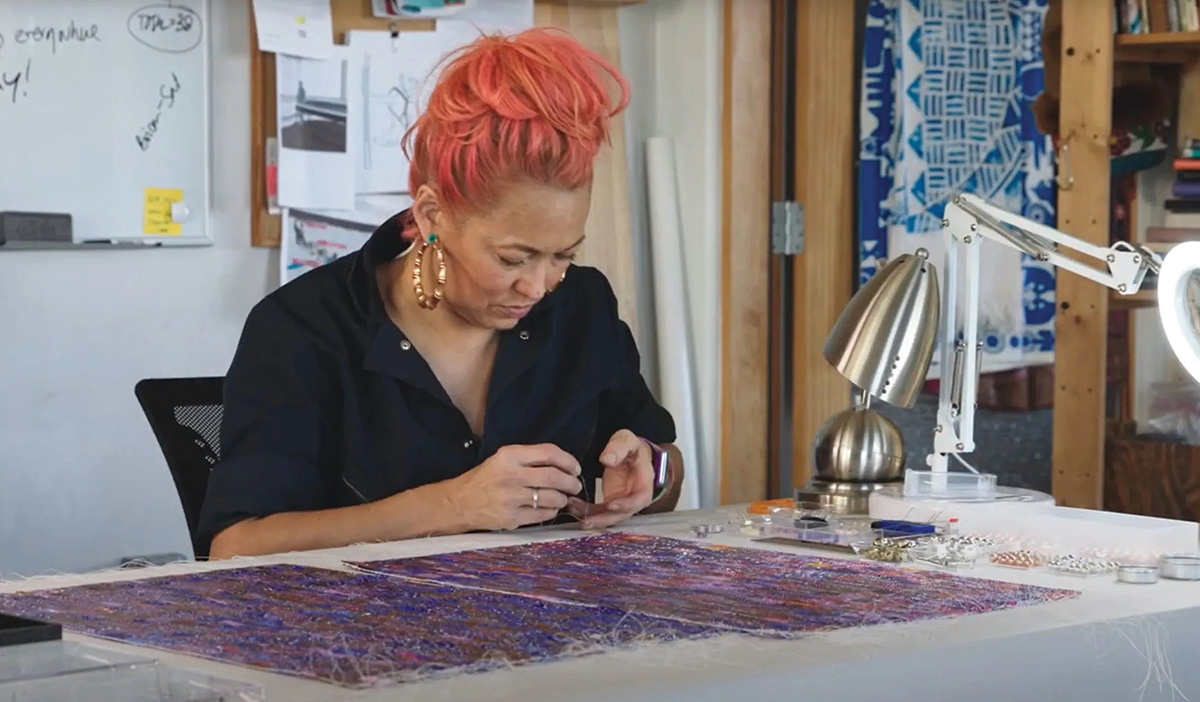
Image by Kaela Waldstein, Mountain Mover Media
Erica Lord, who grew up in the Tanana Athabaskan village of Nenana, Alaska, is a multidisciplinary artist and photographer. As sled dogs have been essential to survival in Alaska Native villages, she also started racing sled dogs at the age of 3. She had 33 dogs as a child.
One of her installations, “The Codes We Carry,” is a series of beaded dog blankets that she painstakingly beaded in patterns that are identical to colored microarray analysis tests of diseases that disproportionately impact Alaska Native communities, including, COVID-19, diphtheria, smallpox, ovarian cancer, tuberculosis and diabetes. Lord said the idea for the work “came from my own frustrations with the medical system and the realization that the things we die of are things that are often preventable if we only had access to quality health care.”
Overall, Lord said she is excited her works are being featured among those of Indigenous artists who inspire her. “I hope that this is the start of more recognition that is overdue to our community,” she said. “I think there are exciting things happening in contemporary Native art right now, and eventually people will realize that we’re part of this larger conversation.”

“Leukemia Burden Strap: DNA/RNA Microarray Analysis”
2022, glass beads and wire; 7.5″ × 94.5″ × .25″.
Photo by Addison Doty. Courtesy of Erica Lord and Accola Griefen Fine Art
“Multiple Myeloma Burden Strap, DNA/RNA Microarray Analysis”
2022, glass beads and wire; 7″ × 60″ × 1.25″.
Photo by Addison Doty, Courtesy of Erica Lord and Accola Griefen Fine Art
Maggie Thompson (Fond du Lac Ojibwe)
Photo Courtesy of Maggie Thompson
Maggie Thompson learned beading at the Minneapolis American Indian Center and then earned her Bachelors of Fine Arts in textiles from the Rhode Island School of Design, where she focused on weaving and mixed-media arts.
Thompson said textiles reflect cultural knowledge as well as stories of survival. “When it is used, held and cared for by many hands, it creates threads of communication across diverse backgrounds and perspectives. … I use textiles as a way to contain memory and reflect.”
Thompson explores Indigenous identity as well as grief, loss and relationships in her art. In her piece, “I Get Mad,” she used tiny seed beads because “of the intensity and insanity of using such a small material to make something much larger. You get lost in the beads, deciphering the different shades of white and clear beads, much like when you are in a toxic relationship.”
Her “On Loving” is a series of vinyl body bags, stitched in a morning star pattern with nearly a million gold beads in honor of the COVID-19 pandemic. Thompson said, “I thought I would be making these alone. I ended up needing help, and so instead they were created by many, many hands, which in the end felt more appropriate, as the work is about collective loss and grief.”
